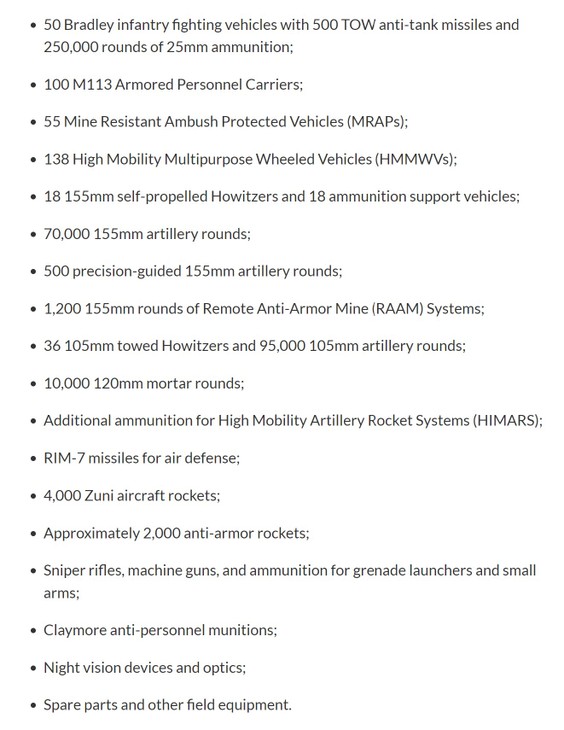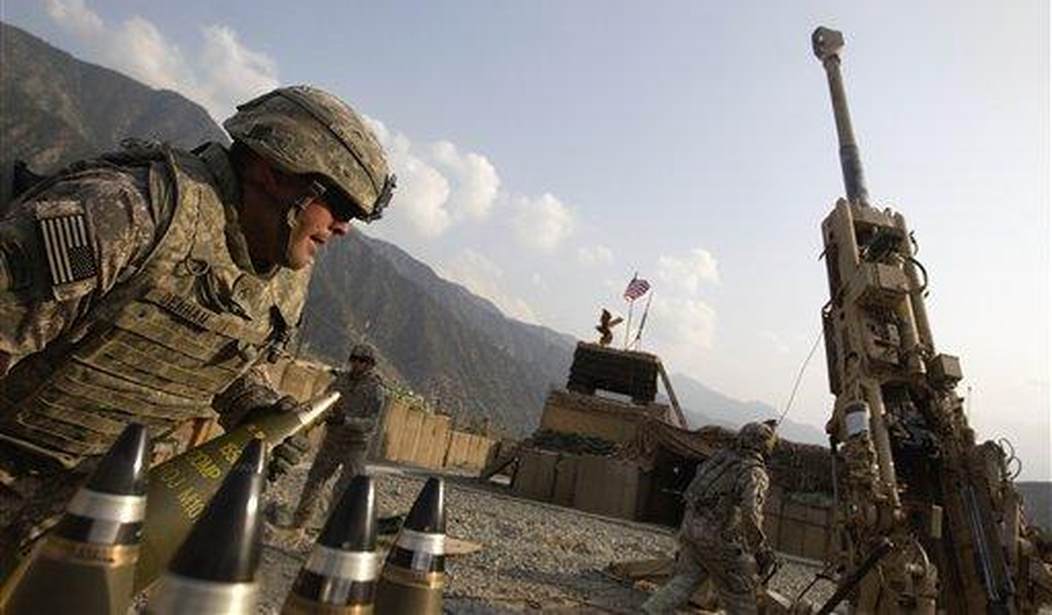Because honest to goodness, it sure seems like we’re doing both and at a cyclic rate.
Monies upon monies. It’s not like we’re in any money trouble ourselves, but the clowns at the Treasury and Fed will just keep printing what Biden needs to cover his butt.
When it comes to ammo and equipment, that’s a horse of a different color entirely. Those have to be procured and manufactured – two things we have sincere difficulties with these days.
Just today, this popped up in my Twitter feed.
The U.S. announced a new $350 million military aid package for Ukraine:
HIMARS ammunition, Bradley ammunition, HARM missiles, anti-tank weapons and river boats. pic.twitter.com/qyKQoi8ah8
— Clash Report (@clashreport) March 20, 2023
Oh, “just another [insert: hundred million dollar multiple]” – no bigs, especially since it’s weapons, not like actual cash or anything.
In actual fact, it is a big deal, and getting bigger every embark box we send them.
As of January 6, we were sending over the following for the 29th shipment or “Presidental Drawdown”…

…with the following price tag:
Today, the Department of Defense (DoD) announces the Biden Administration’s commitment of $3.075 billion in additional security assistance for Ukraine. This includes the authorization of a Presidential Drawdown of security assistance valued at up to $2.85 billion to meet Ukraine’s critical security and defense needs, as well as the Department of State’s announcement of $225 million in Foreign Military Financing to contribute to the long-term capacity and modernization of Ukraine’s military.
The Presidential Drawdown is the twenty-ninth such drawdown of equipment from DoD inventories for Ukraine that the Biden Administration has authorized since August 2021 [list above]….
…In total, the United States has committed more than $24.9 billion in security assistance to Ukraine since the beginning of the Biden Administration. Since 2014, the United States has committed more than $27 billion in security assistance to Ukraine and more than $24.2 billion since the beginning of Russia’s unprovoked and brutal invasion on February 24.
That’s all real stuff, two months ago. Real assets not fluttering on a money tree. We are now, as of today, up to our 34th drawdown. It’s like Biden thinks the DoD is his personal pew-pew/BOOM-BOOM version of the Strategic Petroleum Reserve or something. A cookie jar to be raided and raided.

And now we’re scrambling to send them more, while still not replacing what we would need in the event of a conflict.
Ukraine’s insatiable demand for artillery has for months outpaced Western forecasts, setting off a global hunt for more ammunition and forcing the U.S. to raid its stocks abroad to help Kyiv prepare for its counteroffensive later in the spring.
With some U.S. allies unwilling or unable to supply enough ammunition for Ukraine, the U.S. military is pulling from its munition supplies in a number of locations, including in Israel, South Korea, Germany and Kuwait. These sites, known as prepositioned stocks, are where the U.S. stores everything from trucks to bandages to support American forces around the world.
The first drawdown of munitions from these sites was late last year, U.S. and congressional officials said.
The pressure on the U.S. to take more ammunition from its overseas stocks comes as some of Washington’s allies with the biggest stores of artillery rounds have shied away from supplying Ukraine for fear of being seen by Russia as a party to the fight in Ukraine.
Having dealt with pre-positioned ships – meeting their civilian inventory crews in Subic Bay, PI and hearing the horror stories from Marines in Saudi Arabia when they were first utilized during the first Gulf War – I can tell you from firsthand knowledge that those entities are worthy but not foolproof. And they need to be FULL TO THE GILLS so that whatever mistakes were made loading them for “pre-positioning” or in the inventories themselves can be overcome by the sheer number of supplies.
That’s on top of, most importantly, our forces deploying with enough to get moving in theater immediately and effectively.
Logistics is a fine science.
The Europeans today (with the exception of Hungary) pledged ammo for Ukraine, but they are in a bind themselves.
NEW – EU agrees to supply Ukraine with 1 million rounds of artillery ammunition worth 2 billion euros over the next 12 months.
— Disclose.tv (@disclosetv) March 20, 2023
It’ll be interesting to see where they pull those artillery shells from.
…The pact to jointly procure 155 mm artillery shells will be signed on the sidelines of a meeting of EU foreign and defence ministers in Brussels on Monday, officials said. First orders under the plan could be placed by the end of May.
“This arrangement has been set up very, very quickly,” the senior EU official, speaking on condition of anonymity, told a news briefing on Friday. “All (EU) member states and Norway can participate.”
Ukraine has identified the supply of 155 mm shells as a critical need as it engages in a fierce war of attrition with invading Russian forces, in which both sides are firing thousands of artillery rounds every day.
…as the state of European Union members’ munitions are secret, but not believed to be in any form robust.
With regards to our own need for ramped-up production in the states, an interesting article in Breaking Defense addresses the complications of the procurement side of the house.
American military support has been crucial to Ukraine’s thus far successful efforts to withstand the unjust military invasion Russia launched a year ago. The rapid consumption and difficulties ramping up production of munitions such as Javelins, Stingers, and HIMARS are a wakeup call, however. If supporting Ukraine creates this much stress on our defense industrial base, it is frightening to think about the impact of an extended military campaign in the Taiwan Straits, let alone conflicts on multiple fronts.
There are roughly 200,000 vendors who provide systems, supplies, parts, and manufacturing for Department of Defense programs. A very small number of those — roughly 50 — are prime contractors who deliver the systems used by our forces as well as our allies and partners such as Ukraine. Given the specialized nature of military equipment and the monopsony marketplace that is government contracting, the number of primes drops even further when you look at individual market areas, such as shipbuilding, ground vehicles, or precision munitions, a market status that has remained fairly stable over the past two decades. With essentially one customer for many military systems, it requires active industry and government management to ensure that specific industrial base sectors maintain an adequate number of providers to support defense needs.
Beyond the primes, the vast majority of vendors are subcontractors. Diminishing manufacturing sources and parts obsolescence, shortages, and delays are key elements on the critical path to quickly scaling up production and replenishing supplies provided to Ukraine. Ninety eight percent of second-tier and third-tier suppliers in the munitions industrial base, for example, are single or sole source. These supply chain challenges are prevalent throughout the defense industrial base and are a reflection of the highly specialized nature of defense production.
The author has 4 suggestions for getting cranking. However, stocks are already too low and production is barely beginning to perk up.
…The U.S. also has sought to increase domestic production, but ramping up that effort is a monthslong process as factory lines have to be opened and prepared, and in some cases workers hired. Before the war started, the U.S. could produce roughly 13,000 rounds a month of 155mm ammunition, according to the U.S. Army.
That monthly figure has jumped to about 20,000 rounds this year, and the U.S. hopes to increase it to 50,000 rounds by next year.
…To date, much of the ammunition has come from U.S. military stocks, pushing inventories to levels that were too low, according to some military planners.
The Pentagon declined to comment on the specifics of stockpiles it has drawn from to supply Ukraine.
“The Department has stocks that are located all around the world and we do not withdraw them without the support and consultation from our allies and partners,” Sabrina Singh, deputy press secretary, said in a statement.
How very desperate the situation is becoming will remain dependent on what production does in the immediate future, how much flexibility is in the pipeline to get things moving, how much additional defense treasure Biden sends to Zelensky, and if everyone behaves themselves in the world until we can get our act together.
That’s an awful lot of things that have to all go right. What are the odds?









Join the conversation as a VIP Member